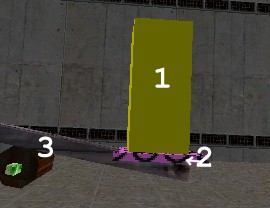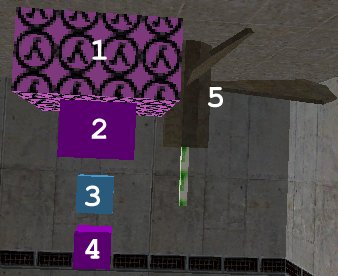Vlatitude: Scripting Tutorial Part 4 - the Seesaw of Death Last edited 2 years ago2022-09-29 07:56:32 UTC
The first thing I'd like to say is that if you haven't read our previous three scripted sequence tutorials, you should do so before attempting this one. In order to understand what this tutorial talks about, you absolutely need to play the example map first.
So you played it. Pretty cool, huh? You might think that this is a difficult sequence to set up, but it's really quite simple. The reason it's so easy actually comes from Half-Life's limitations. Half-Life has a pretty weak realism when it comes to physics in the environment, and the point of this exercise is to work with and against these limitations.
Let's start out with the basic scientist setup. First, we'll look at the scientist standing on the wooden platform. As you can see from the picture, he's actually a scripted_sequence triggered by a trigger_auto. This is not crucial, and I could in fact have the real monster_scientist stand on the platform, but a scripted_sequence allows some more control over the monster_scientist, and is less prone to bugs.The scientist is standing on a rectangular func_breakable platform whose name is board. This board is triggered by scripted_sentence 1, which in turn is triggered by a large trigger_once that the player absolutely has to walk through (not shown). So when the scripted_sentence 1 makes the scientist on top of the crate talk, the supporting board breaks, with a set delay of 3. When this board breaks, the game's physics simulate gravity, and the scientist falls to the floor.
More advanced readers might argue that perhaps a trigger_monsterjump would be a better tool to use in order to get the scientist off that crate. In theory, yes: the scientist would jump off the crate in a more realistic fashion, and we could just remove that strange-looking board. However, this does not work in practice. I've tried it, and the scientist goes sliding along the seesaw after he jumps, until he stands face to face with the other scientist, the seesaw remaining unmoved. I tried it in many variations, and it still didn't work. Close, but no cigar.
Here, we run into our first problem: getting the levered board to move in unison with the falling scientist. To make it realistic, I put a trigger_once brush in the falling scientist's way. This trigger_once targets a multi_manager named event_manager. Here are the values for mister event_manager
- targetname=event_manager
- seesaw=0 (time delay of course)
- spring=0
- scream=.2
I have explained the vital workings of this sequence, so now you have enough knowledge to adjust it to your needs and make it better. You could make it look more realistic by adjusting the scientists' trajectory, making preceding sequences, or changing the func_train's shape. The most important lesson is that sometimes we have to devise ways to make illusions that look realistic and believable.
- Categories
- Archived Articles
- Vlatitude Archive
- Tutorials
- Goldsource Tutorials
- Mapping
- Images Required
- Article Credits
- Vlad – Author
This article was originally published on 69th Vlatitude.
The original URL of the article was http://www.vlatitude.com/tutorials.php?tutID=32.
The archived page is available here.
TWHL only publishes archived articles from defunct websites, or with permission.
For more information on TWHL's archiving efforts, please visit the
TWHL Archiving Project page.
Comments
You must log in to post a comment. You can login or register a new account.



